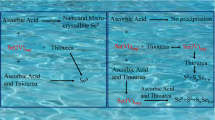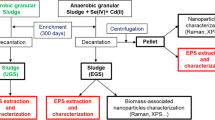Abstract
Total selenium removal by the activated sludge process, where selenite is reduced to colloidal elemental selenium nanoparticles (BioSeNPs) that remain entrapped in the activated sludge flocs, was studied. Total selenium removal efficiencies with glucose as electron donor (2.0 g chemical oxygen demand (COD) L−1) at neutral pH and 30 °C gave 2.9 and 6.8 times higher removal efficiencies as compared to the electron donors lactate and acetate, respectively. Total selenium removal efficiencies of 79 (±3) and 86 (±1) % were achieved in shake flasks and fed batch reactors, respectively, at dissolved oxygen (DO) concentrations above 4.0 mg L−1 and 30 °C when fed with 172 mg L−1 (1 mM) Na2SeO3 and 2.0 g L−1 COD of glucose. Continuously operated reactors operating at neutral pH, 30 °C and a DO >3 mg L−1 removed 33.98 and 36.65 mg of total selenium per gram of total suspended solids (TSS) at TSS concentrations of 1.3 and 3.0 g L−1, respectively. However, selenite toxicity to the activated sludge led to failure of a continuously operating activated sludge reactor at the applied loading rates. This suggests that a higher hydraulic retention time (HRT) or different reactor configurations need to be applied for selenium-removing activated sludge processes.

Scheme representing the possible mechanisms of selenite reduction at high and low DO levels in the activated sludge process






Similar content being viewed by others
References
Ahammad SZ, Davenport RJ, Read LF, Gomes J, Sreekrishnan TR, Dolfing J (2013) Rational immobilization of methanogens in high cell density bioreactors. RSC Adv 3:774–781
APHA (2005) Standard methods for examination of water and wastewater, 5th edn. American Public Health Association, Washington, DC, USA
Bai Y, Rong F, Wang H, Zhou Y, Xie X, Teng J (2011) Removal of copper from aqueous solution by adsorption on elemental selenium nanoparticles. J Chem Eng Data 56:2563–2568
Belzile N, Wu GJ, Chen Y-W, Appanna VD (2006) Detoxification of selenite and mercury by reduction and mutual protection in the assimilation of both elements by Pseudomonas fluorescens. Sci Total Environ 367:704–14
Buchs B, Evangelou MW-H, Winkel L, Lenz M (2013) Colloidal properties of nanoparticular biogenic selenium govern environmental fate and bioremediation effectiveness. Environ Sci Technol 47:2401–2407
Cantafio AW, Hagen KD, Lewis GE, Bledsoe TL, Nunan KM, Macy JM (1996) Pilot-scale selenium bioremediation of San Joaquin drainage water with Thauera selenatis. Appl Environ Microbiol 62:3298–303
Dermou E, Velissariou A, Xenos D, Vayenas DV (2005) Biological chromium(VI) reduction using a trickling filter. J Hazard Mater 126:78–85
Dhanjal S, Cameotra SS (2010) Aerobic biogenesis of selenium nanospheres by Bacillus cereus isolated from coalmine soil. Microb Cell Fact 9:52
Dhanjal S, Cameotra SS (2011) Selenite stress elicits physiological adaptations in Bacillus sp. (Strain JS-2). J Microbiol Biotechnol 21:1184–1192
Espinosa-Ortiz EJ, Gonzalez-Gil G, Saikaly PE, van Hullebusch ED, Lens PNL (2014) Effects of selenium oxyanions on the white-rot fungus Phanerochaete chrysosporium. Appl Microbiol Biotechnol. doi:10.1007/s00253-014-6127-3
Ferro Orozco AM, Contreras EM, Zaritzky NE (2010) Cr(Vi) reduction capacity of activated sludge as affected by nitrogen and carbon sources, microbial acclimation and cell multiplication. J Hazard Mater 176:657–65
Haug A, Graham RD, Christophersen OA, Lyons GH (2007) How to use the world’s scarce selenium resources efficiently to increase the selenium concentration in food. Microb Ecol Health Dis 19:209–228
Hunter WJ, Manter DK (2009) Reduction of selenite to elemental red selenium by Pseudomonas sp. Strain CA5. Curr Microbiol 58:493–8
Jain R, Gonzalez-Gil G, Singh V, van Hullebusch, ED, Farges, F, Lens PNL (2014) Biogenic selenium nanoparticles: production, characterization and challenges. In: Kumar A, Govil JN (eds) Nanobiotechnology. Studium Press LLC, USA, pp 361–390
Jain R, Jordan N, Schild D, van Hullebusch ED, Weiss S, Franzen C, Hubner R, Farges F, Lens PNL (2015a) Adsorption of zinc by biogenic elemental selenium nanoparticles. Chem Eng J 260:850–863
Jain R, Jordan N, Weiss S, Foerstendorf H, Heim K, Kacker R, Hübner R, Kramer H, van Hullebusch ED, Farges F, Lens PNL (2015b) Extracellular polymeric substances govern the surface charge of biogenic elemental selenium nanoparticles. Environ Sci Technol 49:1713–1720
Jain R, Seder-colomina M, Jordan N, Dessi P, Cosmidis J, van Hullebusch ED, Weiss S, Farges F, Lens PNL (2015c) Entrapped elemental selenium nanoparticles affect physicochemical properties of selenium fed activated sludge. J Hazard Mater 295:193–200
Johnson NC, Manchester S, Sarin L, Gao Y, Kulaots I, Hurt RH (2008) Mercury vapor release from broken compact fluorescent lamps and in situ capture by new nanomaterial sorbents. Environ Sci Technol 42:5772–5778
Karya NGA, van der Steen NP, Lens PNL (2013) Photo-oxygenation to support nitrification in an algal-bacterial consortium treating artificial wastewater. Bioresour Technol 134:244–50
Lane DJ (1991) 16S/23S rRNA sequencing. In: Stackebrandt E, Goodfellow M (eds) Nucleic acid techniques in bacterial systematic. John Wiley & Sons, New York, pp 115–175
Lenz M, Lens PNL (2009) The essential toxin: the changing perception of selenium in environmental sciences. Sci Total Environ 407:3620–33
Lenz M, van Hullebusch ED, Hommes G, Corvini PFX, Lens PNL (2008a) Selenate removal in methanogenic and sulfate-reducing upflow anaerobic sludge bed reactors. Water Res 42:2184–2194
Lenz M, Smit M, Binder P, van Aelst AC, Lens PNL (2008b) Biological alkylation and colloid formation of selenium in methanogenic UASB reactors. J Environ Qual 37:1691–700
Li D-B, Cheng Y-Y, Wu C, Li W-W, Li N, Yang Z-C, Tong Z.-H, Yu H-Q (2014) Selenite reduction by Shewanella oneidensis MR-1 is mediated by fumarate reductase in periplasm. Sci Rep 4:3735
Muyzer G, de Waal E, Uitterlinden AG (1993) Profiling of complex microbial populations by denaturing gradient gel electrophoresis analysis of polymerase chain. Appl Environ Microbiol 59:695–700
Oremland RS, Herbel MJ, Blum JS, Langley S, Beveridge TJ, Ajayan PM, Sutto T, Ellis AV, Curran S (2004) Structural and spectral features of selenium nanospheres produced by Se-respiring bacteria. Appl Environ Microbiol 70:52–60
Øvreås L, Forney L, Daae FL, Torsvik V (1997) Distribution of bacterioplankton in meromictic Lake Saelenvannet, as determined by denaturing gradient gel electrophoresis of PCR-amplified gene fragments coding for 16S rRNA. Appl Environ Microbiol 63:3367
Park HJ, Kim HY, Cha S, Ahn CH, Roh J, Park S, Kim S, Choi K, Yi J, Kim Y, Yoon J (2013) Removal characteristics of engineered nanoparticles by activated sludge. Chemosphere 92:524–528
Pearce CI, Pattrick RAD, Law N, Charnock JM, Coker VS, Fellowes JW, Oremland RS, Lloyd JR (2009) Investigating different mechanisms for biogenic selenite transformations: Geobacter sulfurreducens, Shewanella oneidensis and Veillonella atypica. Environ Technol 30:1313–26
Rosen BP, Liu Z (2009) Transport pathways for arsenic and selenium: a minireview. Environ Int 35:512–515
Staicu LC, van Hullebusch ED, Lens PNL, Pilon-Smits EA, Oturan MA (2015) Electrocoagulation of colloidal biogenic selenium. Environ Sci Pollut Res Int 22:3127–3137
Stasinakis AS, Thomaidis NS, Mamais D, Lekkas TD (2004) Investigation of Cr(VI) reduction in continuous-flow activated sludge systems. Chemosphere 57:1069–1077
Tejo Prakash N, Sharma N, Prakash R, Raina KK, Fellowes J, Pearce CI, Lloyd JR, Pattrick RAD (2009) Aerobic microbial manufacture of nanoscale selenium: exploiting nature’s bio-nanomineralization potential. Biotechnol Lett 31:1857–62
Winkel L, Feldmann J, Meharg AA (2010) Quantitative and qualitative trapping of volatile methylated selenium species entrained through nitric acid. Environ Sci Technol 44:382–7
Acknowledgments
The authors are thankful to Ferdi Battles, Lyzette Robbemont, Berend Lolkema (UNESCO-IHE, Delft) for the ICP-MS measurements, as well as Marina Seder-Colomina (Université Paris-Est, Marne la Vallée) and Julie Cosmidis (UPMC Univ Paris 06, Paris) for TEM-EDX measurements. This research was supported through the Erasmus Mundus Joint Doctorate Environmental Technologies for Contaminated Solids, Soils, and Sediments (ETeCoS3) (FPA no. 2010-0009) and the lifelong Learning Program (LLP) Erasmus Placement, both financed by the European Commission.
Authors’ contributions
The manuscript was written through contributions of all authors. All authors have given approval to the final version of the manuscript.
Author information
Authors and Affiliations
Corresponding author
Additional information
Responsible editor: Bingcai Pan
Rights and permissions
About this article
Cite this article
Jain, R., Matassa, S., Singh, S. et al. Reduction of selenite to elemental selenium nanoparticles by activated sludge. Environ Sci Pollut Res 23, 1193–1202 (2016). https://doi.org/10.1007/s11356-015-5138-7
Received:
Accepted:
Published:
Issue Date:
DOI: https://doi.org/10.1007/s11356-015-5138-7




